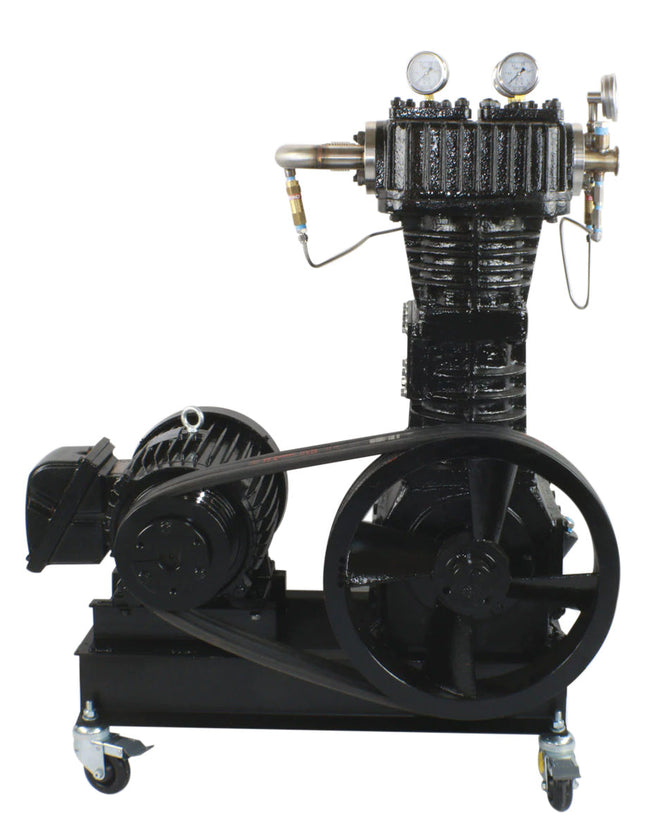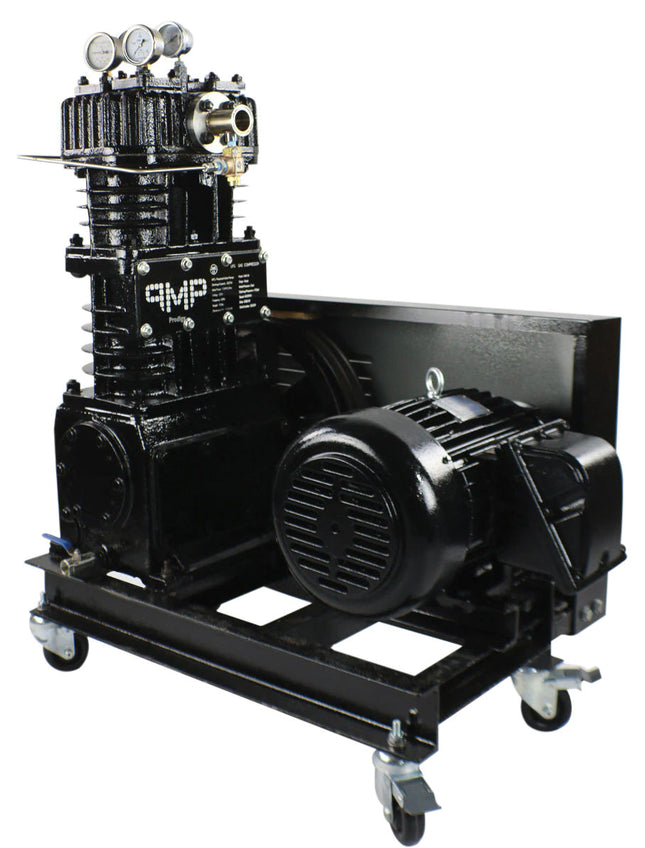PMP Pumps

The Prophet
The Prophet The Prophet is the industries largest and fastest LPG recovery pump. This mammoth pumps at 28 cfm (3.33x the size of a Corken T91) while running quietly at only 68db. Unlike the other recovery pumps available on the market this pump features a dual stage design which allows for greater delta pressure between the inlet and outlet of the pump. This allows for higher output pressures (propane) and lower inlet pressures (vacuum). The ability to pull vacuum against the inlet lowers the boiling point of the recovering solvents allowing them to vaporize faster, speeding up your recovery times. In addition, this pump can be used to pull initial vacuum in the extraction system. 28CFM Dual Stage 10HP Inlet: 1.5” Triclamp Outlet: 1.5” Triclamp Weight: 865lbs Max bearing pressure: 250psi Max discharge pressure: 150psi Max delta pressure: 10x Many factors go into the rate of recovery on an extraction system. Not only is the pump size important, but also the evaporation rate of the solvents. If the solvents aren’t able to evaporate fast enough there will be nothing for the pump to transfer. Larger pumps have the capacity to transfer solvents faster, but only if the solvents are in an evaporated state. Because these pumps are so large they have a tendency to outpace the evaporation rate of most extraction systems. This lowers the inlet pressure (and the collection vessel pressures) which aids in speeding up the evaporation rate. Propane weighs less per gallon than butane (4.2 vs 4.9), however the vapor pressure is higher which generally results in a higher inlet pressure, and therefor a faster recovery per pound of gas used. These pumps are sized large enough to recover on the largest extraction systems with the highest evaporation rates, or can be used on multiple extraction systems at one time. For example this pump was used to recover 5lbs of butane on a 6” vessel with 70° of temperature. The process took ~12 minutes. However increasing the process to 3x 6” vessels with 5lbs of butane each(15lbs total), the process also took ~12 minutes. This is because the pump exceeds the evaporation rate of a single 6” column at 70° by more than 3x. Because the pump exceeds the evaporation rate a vacuum is pulled against the collection vessel, which in turn speeds up the evaporation rate. However once vacuum equilibrium is achieved, increasing the pump size will not speed up the process, but will allow for larger (or multiple) processes to be preformed in the same time frame. The next tab shows a table of recovery capacity with regards to inlet pressures. Higher inlet pressures result in substantially faster recovery times. Higher inlet pressures can be achieved by evaporating solvents faster by higher temperatures in collection vessels, or more surface area in collection vessels (larger diameter vessels, falling, etc). Inlet Pressure LBS per Minute Butane LBS per Minute Propane -13 psi (Vacuum) .56 .41 -10 psi (Vacuum) 1.12 .81 -7 psi (Vacuum) 2.24 1.63 -4 psi (Vacuum) 3.36 2.44 0 psi 4.49 3.26 15 psi 8.97 6.52 29 psi 13.46 9.77
$25,549.85

The Prodigy
THE PRODIGY Description: 24CFM Single Stage 7.5HP 220V – 3 Phase (Single Phase Inverters Available) Inlet: 1.5” Triclamp Outlet: 1.5” Triclamp Weight: 750lbs Max bearing pressure: 250psi Max discharge pressure: 150psi Max delta pressure: 10x Many factors go into the rate of recovery on an extraction system. Not only is the pump size important, but also the evaporation rate of the solvents. If the solvents aren’t able to evaporate fast enough there will be nothing for the pump to transfer. Larger pumps have the capacity to transfer solvents faster, but only if the solvents are in an evaporated state. Because these pumps are so large they have a tendency to outpace the evaporation rate of most extraction systems. This lowers the inlet pressure (and the collection vessel pressures) which aids in speeding up the evaporation rate. Propane weighs less per gallon than butane (4.2 vs 4.9), however the vapor pressure is higher which generally results in a higher inlet pressure, and therefor a faster recovery per pound of gas used. These pumps are sized large enough to recover on the largest extraction systems with the highest evaporation rates, or can be used on multiple extraction systems at one time. For example this pump was used to recover 5lbs of butane on a 6” vessel with 70° of temperature. The process took ~12 minutes. However increasing the process to 3x 6” vessels with 5lbs of butane each(15lbs total), the process also took ~12 minutes. This is because the pump exceeds the evaporation rate of a single 6” column at 70° by more than 3x. Because the pump exceeds the evaporation rate a vacuum is pulled against the collection vessel, which in turn speeds up the evaporation rate. However once vacuum equilibrium is achieved, increasing the pump size will not speed up the process, but will allow for larger (or multiple) processes to be preformed in the same time frame. The next tab shows a table of recovery capacity with regards to inlet pressures. Higher inlet pressures result in substantially faster recovery times. Higher inlet pressures can be achieved by evaporating solvents faster by higher temperatures in collection vessels, or more surface area in collection vessels (larger diameter vessels, falling film, etc). Inlet Pressure LBS per Minute Butane LBS per Minute Propane -13 psi (Vacuum) .48 .35 -10 psi (Vacuum) .96 .7 -7 psi (Vacuum) 1.92 1.4 -4 psi (Vacuum) 2.88 2.09 0 psi 3.84 2.79 15 psi 7.69 5.59 29 psi 11.53 8.38
$21,291.54



